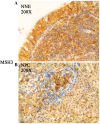Inactivation of MSH3 by promoter methylation correlates with primary tumor stage in nasopharyngeal carcinoma
- PMID: 28656302
- PMCID: PMC5547962
- DOI: 10.3892/ijmm.2017.3044
Inactivation of MSH3 by promoter methylation correlates with primary tumor stage in nasopharyngeal carcinoma
Abstract
The aim of this study was to investigate the inactivation of the MutS homolog human 3 (MSH3) gene by promoter methylation in nasopharyngeal carcinoma (NPC). Methylation‑specific PCR, semi‑quantitative reverse transcription PCR and immunohistochemical analysis were used to detect methylation and the mRNA and protein expression levels of MSH3 in 54 cases of NPC tissues and 16 cases of normal nasopharyngeal epithelial (NNE) tissues. The association between promoter methylation and mRNA expression, and the mRNA and protein expression of the gene and clinical factors was analyzed. The promoter methylation of MSH3 was detected in 50% (27/54) of the primary tumors, but not in the 16 NNE tissues. The mRNA and protein expression levels were significantly decreased in the 54 cases of human NPC as compared to the 16 NNE tissues (P<0.05). The MSH3‑methylated cases exhibited significantly lower mRNA and protein expression levels than the unmethylated cases (P<0.05). The MSH3 mRNA and protein expression levels were significantly associated with the variable T stage (P<0.05); however, they did not correlate with the age and sex of the patients, or with the N stage, TNM classification or histopathological subtype (P>0.05). On the whole, MSH3 was frequently inactivated by promoter methylation and its mRNA and protein expression correlated with the primary tumor stage in NPC.
Figures




Similar articles
-
[Inactivation of PMS2 gene by promoter methylation in nasopharyngeal carcinoma].Zhonghua Zhong Liu Za Zhi. 2016 Nov 23;38(11):812-817. doi: 10.3760/cma.j.issn.0253-3766.2016.11.003. Zhonghua Zhong Liu Za Zhi. 2016. PMID: 27998438 Chinese.
-
Inactivation of parkin by promoter methylation correlated with lymph node metastasis and genomic instability in nasopharyngeal carcinoma.Tumour Biol. 2017 Mar;39(3):1010428317695025. doi: 10.1177/1010428317695025. Tumour Biol. 2017. PMID: 28351314
-
Inactivation of RASSF2A by promoter methylation correlates with lymph node metastasis in nasopharyngeal carcinoma.Int J Cancer. 2007 Jan 1;120(1):32-8. doi: 10.1002/ijc.22185. Int J Cancer. 2007. PMID: 17013896
-
Diagnostic Capacity of RASSF1A Promoter Methylation as a Biomarker in Tissue, Brushing, and Blood Samples of Nasopharyngeal Carcinoma.EBioMedicine. 2017 Apr;18:32-40. doi: 10.1016/j.ebiom.2017.03.038. Epub 2017 Apr 2. EBioMedicine. 2017. PMID: 28396012 Free PMC article. Review.
-
Association of E-cadherin methylation with risk of nasopharyngeal cancer: A meta-analysis.Head Neck. 2018 Nov;40(11):2538-2545. doi: 10.1002/hed.25319. Epub 2018 Jun 26. Head Neck. 2018. PMID: 29947108 Review.
Cited by
-
MutSα expression predicts a lower disease-free survival in malignant salivary gland tumors: an immunohistochemical study.Med Oral Patol Oral Cir Bucal. 2022 Mar 1;27(2):e164-e173. doi: 10.4317/medoral.25138. Med Oral Patol Oral Cir Bucal. 2022. PMID: 35218645 Free PMC article.
-
Gastric adenocarcinoma with high‑level microsatellite instability: A case report.Mol Clin Oncol. 2023 Jan 26;18(3):16. doi: 10.3892/mco.2023.2612. eCollection 2023 Mar. Mol Clin Oncol. 2023. PMID: 36798468 Free PMC article.
-
Prevalence of elevated microsatellite alterations at selected tetranucleotide repeats in pancreatic ductal adenocarcinoma.PLoS One. 2018 Dec 7;13(12):e0208557. doi: 10.1371/journal.pone.0208557. eCollection 2018. PLoS One. 2018. PMID: 30532127 Free PMC article.
-
Identification of disulfidptosis related subtypes, characterization of tumor microenvironment infiltration, and development of DRG prognostic prediction model in RCC, in which MSH3 is a key gene during disulfidptosis.Front Immunol. 2023 Jun 23;14:1205250. doi: 10.3389/fimmu.2023.1205250. eCollection 2023. Front Immunol. 2023. PMID: 37426643 Free PMC article.
-
Combined Microsatellite Instability and Elevated Microsatellite Alterations at Selected Tetranucleotide Repeats (EMAST) Might Be a More Promising Immune Biomarker in Colorectal Cancer.Oncologist. 2019 Dec;24(12):1534-1542. doi: 10.1634/theoncologist.2019-0171. Epub 2019 Jul 10. Oncologist. 2019. PMID: 31292272 Free PMC article.
References
-
- Fishel R. The selection for mismatch repair defects in hereditary nonpolyposis colorectal cancer: revising the mutator hypothesis. Cancer Res. 2001;61:7369–7374. - PubMed
MeSH terms
Substances
LinkOut - more resources
Full Text Sources
Other Literature Sources

